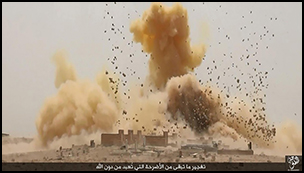Crossref Citations
This article has been cited by the following publications. This list is generated based on data provided by
Crossref.
Richardson, Lorna-Jane
2019.
Using Social Media as a Source for Understanding Public Perceptions of Archaeology: Research Challenges and Methodological Pitfalls.
Journal of Computer Applications in Archaeology,
Vol. 2,
Issue. 1,
p.
151.
Isakhan, Benjamin
and
Meskell, Lynn
2019.
UNESCO’s project to ‘Revive the Spirit of Mosul’: Iraqi and Syrian opinion on heritage reconstruction after the Islamic State.
International Journal of Heritage Studies,
Vol. 25,
Issue. 11,
p.
1189.
Borau, Sylvie
and
Wamba, Samuel Fosso
2019.
New Knowledge in Information Systems and Technologies.
Vol. 930,
Issue. ,
p.
143.
Taçon, Paul S.C.
and
Baker, Sarah
2019.
New and Emerging Challenges to Heritage and Well-Being: A Critical Review.
Heritage,
Vol. 2,
Issue. 2,
p.
1300.
Isakhan, Benjamin
and
Shahab, Sofya
2020.
The Islamic State’s destruction of Yezidi heritage: Responses, resilience and reconstruction after genocide.
Journal of Social Archaeology,
Vol. 20,
Issue. 1,
p.
3.
Matthews, Roger
Rasheed, Qais Hussain
Palmero Fernández, Mónica
Fobbe, Seán
Nováček, Karel
Mohammed-Amin, Rozhen
Mühl, Simone
and
Richardson, Amy
2020.
Heritage and cultural healing: Iraq in a post-Daesh era.
International Journal of Heritage Studies,
Vol. 26,
Issue. 2,
p.
120.
Hajibayova, Lala
2020.
An investigation of cultural objects in conflict zones through the lens of TripAdvisor reviews: A case of South Caucasus.
Journal of Information Science,
Vol. 46,
Issue. 5,
p.
710.
Venditti, Caterina Paola
and
Mele, Paolo
2020.
Developing Effective Communication Skills in Archaeology.
p.
224.
Witcher, Robert
2020.
Editorial.
Antiquity,
Vol. 94,
Issue. 373,
p.
1.
Rebat Al-kanany, Muhsin Mahdi
2020.
Extremist iconoclasm versus real Islamic values: implications for heritage-based tourism development in Iraq.
Journal of Heritage Tourism,
Vol. 15,
Issue. 4,
p.
472.
Zaina, Federico
Proserpio, Licia
and
Scazzosi, Giulia
2021.
Local voices on heritage: Understanding community perceptions towards archaeological sites in South Iraq.
Journal of Community Archaeology & Heritage,
Vol. 8,
Issue. 4,
p.
256.
Zaina, Federico
and
Nabati Mazloumi, Yasaman
2021.
A multi‐temporal satellite‐based risk analysis of archaeological sites in Qazvin plain (Iran).
Archaeological Prospection,
Vol. 28,
Issue. 4,
p.
467.
Kentour, Mohamed
Lu, Joan
and
Gadekallu, Thippa Reddy
2021.
An investigation into the deep learning approach in sentimental analysis using graph-based theories.
PLOS ONE,
Vol. 16,
Issue. 12,
p.
e0260761.
Canhoto, Ana Isabel
2021.
Leveraging machine learning in the global fight against money laundering and terrorism financing: An affordances perspective.
Journal of Business Research,
Vol. 131,
Issue. ,
p.
441.
Hrabalová, Lenka
2022.
Dějiny v troskách.
Wilson, Andrew S.
Gaffney, Vincent
Gaffney, Chris
Ch’ng, Eugene
Bates, Richard
Ichumbaki, Elgidius B.
Sears, Gareth
Sparrow, Tom
Murgatroyd, Andrew
Faber, Eddy
Evans, Adrian
and
Coningham, Robin
2022.
Visual Heritage: Digital Approaches in Heritage Science.
p.
51.
Payntar, Nicole D.
2022.
Community Heritage in the Arab Region.
p.
261.
Andreou, Georgia M.
Nikolaus, Julia
Westley, Kieran
el Safadi, Crystal
Blue, Lucy
Smith, Ash
and
Breen, Colin
2022.
Big Data in Maritime Archaeology: Challenges and Prospects from the Middle East and North Africa.
Journal of Field Archaeology,
Vol. 47,
Issue. 3,
p.
131.
Mantilla, Luis Felipe
and
Knezevic, Zorana
2022.
Explaining intentional cultural destruction in the Syrian Civil War.
Journal of Peace Research,
Vol. 59,
Issue. 4,
p.
562.
Lee, Claire Seungeun
and
Colautti, John D.
2022.
ISIS’s COVID-19 Messaging on Twitter: An Analysis of Tweet Sentiment and Emotions.
Crime & Delinquency,
Vol. 68,
Issue. 8,
p.
1347.





